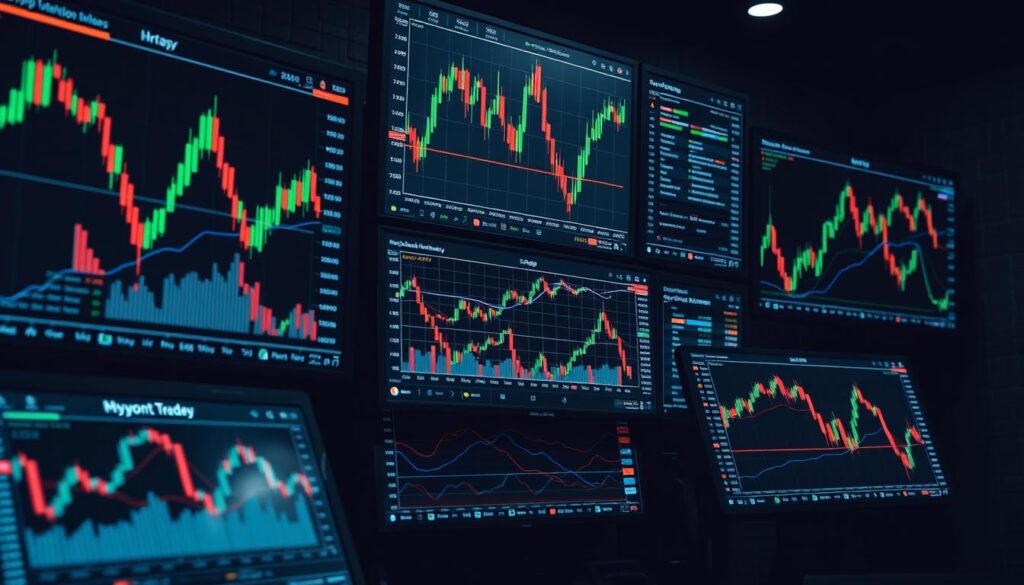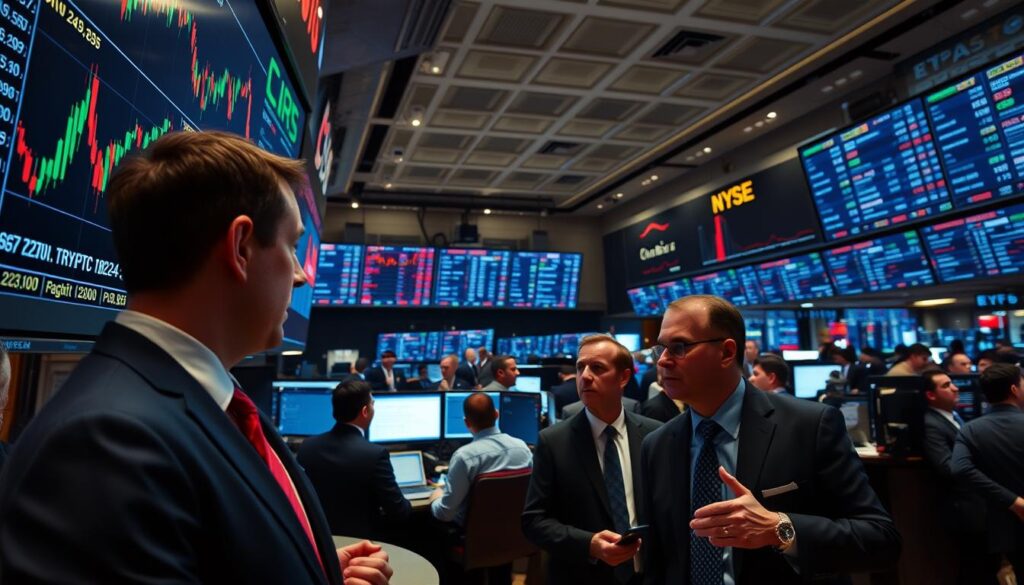Now Reading: Complete Guide to Crypto Market Sector Analysis DeFi NFT Gaming
- 01
Complete Guide to Crypto Market Sector Analysis DeFi NFT Gaming
Complete Guide to Crypto Market Sector Analysis DeFi NFT Gaming

The digital financial landscape has transformed dramatically with the emergence of blockchain technology. Crypto market analysis now spans critical sectors including DeFi, NFT markets, and blockchain gaming. Investors seeking comprehensive insights must understand the intricate dynamics of these rapidly evolving ecosystems.
This guide provides an in-depth exploration of crypto market analysis techniques across decentralized finance, non-fungible tokens, and innovative gaming platforms. By examining sector-specific metrics, technological advancements, and investment strategies, readers will gain actionable intelligence for navigating the complex crypto marketplace.
Decentralized finance, NFT markets, and blockchain gaming represent cutting-edge investment frontiers. Each sector offers unique opportunities and challenges that demand specialized analytical approaches. Understanding these nuanced environments requires strategic knowledge and sophisticated evaluation methods.
Key Takeaways
- Comprehensive overview of crypto market sector analysis
- Detailed insights into DeFi, NFT, and blockchain gaming ecosystems
- Advanced analytical frameworks for investment decision-making
- Understanding technological innovations driving crypto markets
- Strategies for evaluating emerging digital asset opportunities
Understanding the Crypto Market Ecosystem
The crypto ecosystem represents a complex and dynamic landscape of digital financial interactions. Emerging as a revolutionary approach to financial transactions, this ecosystem encompasses a wide range of participants, technologies, and market structures that continue to evolve rapidly.
Navigating the intricate world of cryptocurrency requires a deep understanding of its fundamental components and interconnected networks. From individual investors to institutional players, the crypto market has developed a sophisticated infrastructure that challenges traditional financial paradigms.
Key Market Participants and Stakeholders
The crypto ecosystem includes diverse market participants who drive innovation and market dynamics:
- Individual retail investors
- Institutional investors
- Cryptocurrency exchanges
- Blockchain developers
- Venture capital firms specializing in crypto investments
Market Infrastructure and Trading Venues
Crypto trading venues have transformed how digital assets are bought, sold, and traded. These platforms provide critical infrastructure for market participants, offering various services from spot trading to complex derivative products.
- Centralized exchanges (CEXs)
- Decentralized exchanges (DEXs)
- Peer-to-peer trading platforms
- Crypto derivatives markets
Regulatory Environment Impact
The regulatory landscape significantly shapes the crypto ecosystem. Government policies and regulatory frameworks play a crucial role in determining market stability, investor protection, and overall market development. Regulatory compliance has become a critical factor for crypto market participants.
Key regulatory considerations include:
- Anti-money laundering (AML) guidelines
- Know Your Customer (KYC) requirements
- Tax reporting obligations
- Securities regulations
Understanding these complex interactions helps investors and stakeholders navigate the dynamic crypto market with greater confidence and strategic insight.
Fundamentals of Crypto Market Sector Analysis: DeFi, NFT, and Gaming
Understanding sector analysis basics requires a deep dive into the unique characteristics of blockchain-powered markets. The crypto ecosystem spans multiple dynamic sectors, each with distinct analytical approaches and critical metrics.
DeFi fundamentals represent a revolutionary financial landscape where traditional banking constraints disappear. Investors must evaluate key performance indicators like:
- Total Value Locked (TVL)
- Protocol Revenue
- User Adoption Rates
- Smart Contract Security
NFT market overview reveals a complex digital asset ecosystem. Successful analysis involves tracking:
- Collection Volume
- Unique Holder Count
- Floor Price Trends
- Trading Frequency
Blockchain gaming essentials encompass unique economic models that blend entertainment with financial incentives. Critical analytical components include:
| Metric | Description |
|---|---|
| Daily Active Users | Player engagement measurement |
| Token Economics | In-game currency valuation |
| Player Retention | Long-term user commitment |
Investors navigating these sectors must develop sophisticated analytical frameworks that transcend traditional market research methodologies. Understanding the nuanced interplay between technology, user behavior, and economic dynamics becomes paramount in crypto market sector analysis.
DeFi Market Analysis Framework
Decentralized Finance (DeFi) has revolutionized the financial landscape, offering investors a comprehensive approach to understanding blockchain-based financial ecosystems. DeFi analysis provides critical insights into the performance and potential of decentralized protocols.
Investors and researchers leverage multiple key metrics to evaluate the health and growth of DeFi platforms. These metrics help uncover the underlying dynamics of decentralized financial systems.
Total Value Locked (TVL) Metrics
Total Value Locked represents the fundamental measure of DeFi protocol strength. TVL tracks the total capital invested in a specific blockchain protocol, indicating:
- Platform liquidity and user engagement
- Investor confidence in the protocol
- Comparative performance across different platforms
Protocol Revenue Analysis
Analyzing protocol revenue provides deeper insights into the economic sustainability of DeFi projects. Key considerations include:
- Fee generation mechanisms
- Revenue distribution models
- Profit margins and financial efficiency
User Adoption Trends
DeFi adoption trends reflect the growing mainstream interest in decentralized financial solutions. Tracking user growth helps understand:
- Emerging user demographics
- Geographic expansion of DeFi platforms
- User retention and engagement rates
By combining these analytical approaches, investors can develop a robust understanding of the DeFi market’s potential and challenges.
NFT Market Dynamics and Valuation Methods

The NFT market has transformed digital ownership, creating a complex ecosystem of digital collectibles with unique valuation challenges. Digital collectibles analysis requires understanding multiple factors that influence pricing and market trends.
Key elements driving NFT valuation include:
- Rarity and scarcity of the digital asset
- Creator reputation and historical sales performance
- Blockchain provenance and authenticity
- Current market sentiment and demand
NFT market trends demonstrate significant volatility, with some digital collectibles experiencing dramatic price fluctuations. Investors must conduct thorough research to assess potential value and investment opportunities.
Comprehensive NFT valuation strategies involve:
- Examining historical trading volumes
- Analyzing community engagement
- Evaluating underlying artwork or utility
- Tracking blockchain metadata
Professional traders leverage advanced analytical tools to predict digital collectibles’ potential value, understanding that each NFT represents a unique digital asset with intrinsic and speculative worth.
Blockchain Gaming Sector Performance Metrics
The blockchain gaming industry has emerged as a dynamic sector with unique performance indicators that go beyond traditional gaming metrics. Investors and developers are increasingly focusing on blockchain gaming metrics to understand the ecosystem’s growth and potential.
Blockchain gaming analytics provide critical insights into the sector’s health and development. These metrics help stakeholders evaluate project viability and potential investment opportunities.
Daily Active Users (DAU) Analysis
Gaming DAU analysis reveals the engagement levels of blockchain games. Key aspects include:
- Number of unique players per day
- User interaction frequency
- Game-specific engagement patterns
Gaming Token Economics
Token economics play a crucial role in blockchain gaming ecosystems. Understanding the monetary dynamics helps assess a game’s financial sustainability.
| Metric | Description | Impact |
|---|---|---|
| Token Supply | Total circulating tokens | Determines market value |
| Token Utility | In-game economic functions | Drives player motivation |
| Reward Mechanism | Player incentive structure | Influences long-term engagement |
Player Retention Rates
Player retention is a critical metric for blockchain gaming projects. Sustainable user engagement indicates a game’s long-term potential and economic viability.
- Track repeat user interactions
- Analyze gameplay duration
- Evaluate reward effectiveness
Technical Analysis Tools for Crypto Sectors
Crypto technical analysis has become an essential skill for investors navigating the complex world of digital assets. Traders leverage specialized tools and sector-specific indicators to decode trading patterns and make informed investment decisions across different cryptocurrency markets.

Effective crypto technical analysis requires understanding unique sector-specific indicators tailored to different blockchain ecosystems. Traders can utilize multiple analytical approaches to gain deeper market insights:
- Candlestick pattern recognition for cryptocurrency price movements
- Volume-based momentum indicators
- Relative strength index (RSI) for market sentiment
- Moving average convergence divergence (MACD) tracking
Different cryptocurrency sectors demand nuanced analytical strategies. DeFi tokens, NFT markets, and blockchain gaming cryptocurrencies each present unique trading patterns that require specialized technical analysis techniques.
| Crypto Sector | Key Technical Indicators | Analysis Focus |
|---|---|---|
| DeFi Tokens | Total Value Locked (TVL) | Protocol Performance |
| NFT Markets | Trading Volume | Market Liquidity |
| Gaming Cryptocurrencies | Daily Active Users | User Engagement |
Advanced traders combine multiple technical analysis tools to create comprehensive market strategies. Developing a robust analytical approach helps investors identify potential opportunities and manage risk effectively.
Market Sentiment Indicators in DeFi
Understanding the psychological landscape of decentralized finance requires deep insights into market sentiment. DeFi sentiment analysis provides crucial signals about investor perception and project potential. By examining multiple indicators, investors can gain a comprehensive view of the market’s emotional and rational dynamics.
Tracking market sentiment involves several key methodological approaches that help investors and researchers decode the complex world of decentralized finance.
Social Media Analytics
Social media metrics play a critical role in gauging public perception of DeFi projects. These platforms offer real-time insights into investor opinions, community engagement, and emerging trends. Researchers utilize advanced sentiment tracking tools to analyze:
- Volume of mentions across platforms
- Sentiment polarity (positive/negative discussions)
- Engagement rates with project-related content
- Influencer commentary and reactions
Development Activity Metrics
Development activity serves as a robust indicator of project health and potential. Investors closely monitor GitHub repositories, commit frequencies, and code contribution patterns to assess the technical vitality of DeFi protocols.
- Number of active developers
- Frequency of code updates
- Quality and complexity of technical improvements
- Open-source collaboration metrics
Investor Confidence Index
The investor confidence index synthesizes multiple data points to create a holistic view of market perception. This comprehensive metric integrates social media sentiment, development activity, trading volumes, and historical performance to provide a nuanced understanding of market psychology.
By leveraging these sophisticated sentiment indicators, investors can make more informed decisions in the dynamic world of decentralized finance.
Cross-sector Investment Opportunities

Exploring crypto sector synergies reveals exciting multi-sector investments that can transform traditional portfolio management. The interconnected nature of DeFi, NFTs, and blockchain gaming creates unique diversification strategies for savvy investors.
Investors can leverage cross-sector opportunities by understanding the intricate relationships between different crypto market segments. These strategic approaches allow for more robust investment frameworks that minimize risk and maximize potential returns.
- DeFi protocols with gaming token integrations
- NFT-backed financial products
- Blockchain gaming platforms with decentralized financial mechanisms
Key investment strategies include:
- Analyzing ecosystem interconnectedness
- Identifying complementary sector developments
- Tracking cross-platform innovation trends
| Sector | Investment Potential | Synergy Factor |
|---|---|---|
| DeFi | High liquidity mechanisms | Financial infrastructure |
| NFTs | Digital asset valuation | Unique ownership models |
| Gaming | User engagement metrics | Economic interaction platforms |
Successful multi-sector investments require deep understanding of technological innovations and market dynamics. Crypto sector synergies present unprecedented opportunities for investors willing to explore interconnected blockchain ecosystems.
Risk Assessment in Crypto Sectors
Navigating the complex landscape of cryptocurrency investments requires a comprehensive approach to crypto risk assessment. Investors must develop sophisticated strategies to identify and mitigate potential threats across DeFi, NFT, and gaming sectors.
Successful risk management in the crypto ecosystem involves multiple critical components that protect investors from potential financial losses.
Smart Contract Risk Analysis
Smart contract risks represent a significant challenge for crypto investors. These digital agreements can contain vulnerabilities that malicious actors might exploit. Key areas of investigation include:
- Code complexity and potential security gaps
- Historical audit records
- Developer reputation and track record
- Formal verification processes
Market Manipulation Indicators
Detecting market manipulation requires careful monitoring of trading patterns and blockchain activity. Investors should watch for:
- Unusual trading volume spikes
- Concentrated wallet activities
- Rapid price fluctuations without fundamental triggers
- Coordinated social media campaigns
Liquidity Risk Factors
Liquidity risks can significantly impact cryptocurrency investments. Evaluating market depth and trading volumes helps investors understand potential exit challenges.
Investors must assess token float, exchange listings, and trading pairs to gauge true liquidity potential. Sophisticated crypto risk assessment strategies involve analyzing:
- Total trading volume
- Number of active exchanges
- Bid-ask spread
- Market depth charts
By implementing robust risk assessment techniques, investors can navigate the volatile crypto landscape with greater confidence and strategic insight.
Emerging Trends in GameFi
The GameFi landscape is rapidly transforming the traditional gaming industry through innovative blockchain game development strategies. Play-to-earn models have revolutionized how players interact with digital gaming ecosystems, creating unprecedented economic opportunities for gamers worldwide.
Key GameFi trends are reshaping the digital entertainment landscape:
- Integration of blockchain technology in game mechanics
- Decentralized ownership of in-game assets through NFTs
- Economic incentives for player participation
- Cross-platform gaming experiences
Blockchain game development now focuses on creating immersive experiences that go beyond traditional gaming models. Players can now earn real economic value through their gaming skills and time investment. These innovative play-to-earn models enable users to monetize their gameplay through cryptocurrency rewards and tradable digital assets.
Emerging platforms are developing sophisticated ecosystems where game economies become increasingly complex and interconnected. Tokenization of in-game items, character progression, and skill-based rewards are transforming how players perceive digital entertainment.
Investors and game developers are recognizing the massive potential of GameFi, with venture capital flowing into blockchain gaming startups at unprecedented rates. The convergence of gaming, blockchain technology, and financial incentives represents a paradigm shift in digital entertainment.
DeFi Yield Analysis Strategies
Navigating the complex world of decentralized finance (DeFi) requires a strategic approach to understanding yield generation and risk management. Investors seeking to maximize their crypto investments must develop sophisticated DeFi yield analysis techniques that go beyond simple return calculations.
Successful DeFi yield farming demands a comprehensive understanding of multiple critical factors. Investors need to evaluate several key components to make informed decisions:
- Annual Percentage Yield (APY) comparison across different protocols
- Risk-adjusted return calculations
- Impermanent loss potential
- Liquidity pool dynamics
APY Comparison Methods
DeFi yield analysis begins with accurate APY comparison. Not all yields are created equal, and investors must dig deeper than surface-level percentages. Key considerations include:
- Platform reputation and security
- Token volatility
- Liquidity pool depth
- Smart contract audits
Risk-Adjusted Returns
Calculating risk-adjusted returns helps investors understand the true value of a potential investment. Sophisticated DeFi participants use metrics like the Sharpe ratio to normalize returns against potential risks. This approach provides a more nuanced view of potential yield generation strategies.
Impermanent Loss Calculation
Impermanent loss represents a critical risk in liquidity provision. Investors must carefully analyze potential token price divergences that could erode expected returns. Advanced strategies involve:
- Monitoring token price correlations
- Selecting stable asset pairs
- Using dynamic hedging techniques
By mastering these DeFi yield analysis techniques, investors can develop more robust and strategic approaches to crypto asset management.
NFT Collection Evaluation Framework

Navigating the complex world of NFT investments requires a strategic approach to NFT collection analysis. Investors need robust methods to assess the potential and value of digital assets in an increasingly competitive marketplace.
A comprehensive NFT project evaluation involves multiple critical dimensions:
- Rarity assessment of individual tokens
- Project team credibility
- Blockchain platform compatibility
- Community engagement metrics
When conducting NFT collection analysis, investors should focus on key performance indicators that signal long-term value. The blockchain gaming market provides insights into digital asset valuation strategies.
| Evaluation Criteria | Weight | Assessment Method |
|---|---|---|
| Token Rarity | 30% | Trait scarcity analysis |
| Creator Reputation | 25% | Historical project performance |
| Market Liquidity | 20% | Trading volume tracking |
| Community Strength | 15% | Social media engagement |
| Utility Potential | 10% | Functional use cases |
Advanced investors leverage data-driven tools from platforms like crypto analytics platforms to enhance their NFT project evaluation process. Understanding these metrics helps mitigate investment risks and identify promising digital collectibles.
Institutional Investment Flows Analysis
Institutional crypto investments have transformed the digital asset landscape, creating new opportunities for sophisticated market participants. Fund flow analysis reveals critical insights into how large-scale investors navigate the complex cryptocurrency ecosystem.
Key areas of institutional adoption trends include:
- Cryptocurrency hedge funds
- Corporate treasury allocations
- Institutional investment vehicles
- Regulated crypto investment products
Tracking institutional capital movements provides valuable signals about market sentiment and potential growth trajectories. Investors can leverage these insights to understand strategic positioning within different crypto sectors.
| Investment Category | Annual Growth Rate | Institutional Interest |
|---|---|---|
| Crypto Hedge Funds | 42% | High |
| Bitcoin Investment Trusts | 35% | Very High |
| Ethereum Investment Products | 28% | Moderate |
Advanced fund flow analysis techniques help investors detect emerging trends in institutional crypto investments. By examining capital allocation patterns, researchers can predict potential market shifts and sector-specific developments.
Sophisticated tracking mechanisms enable deeper understanding of institutional adoption trends. Data-driven insights now play a crucial role in evaluating cryptocurrency market dynamics and potential investment opportunities.
Market Correlation Studies
Crypto market correlations represent a complex landscape of interconnected digital assets that continually evolve. Investors and analysts seek to understand the intricate relationships between different cryptocurrency sectors to develop more sophisticated investment strategies.
The cryptocurrency ecosystem demonstrates unique patterns of sector interdependencies that challenge traditional financial market assumptions. Researchers analyzing data from comprehensive blockchain studies have uncovered fascinating insights into how different crypto sectors interact.
Inter-sector Dependencies
Crypto market sectors exhibit nuanced relationships that can be categorized through several key observations:
- DeFi platforms often show stronger correlations with Ethereum-based tokens
- NFT markets demonstrate more volatile interdependencies
- Gaming tokens tend to have unique correlation patterns
External Market Influences
External market factors play a critical role in shaping crypto market dynamics. Macroeconomic trends, regulatory changes, and global financial events can significantly impact cryptocurrency sector performance.
| Market Sector | Correlation Strength | Volatility Index |
|---|---|---|
| DeFi | 0.65 | High |
| NFT | 0.42 | Medium |
| Gaming | 0.33 | Low |
Investors can leverage these insights to develop more sophisticated cross-sector investment strategies that account for the complex interactions within the cryptocurrency ecosystem.
Portfolio Diversification Strategies
Crafting a robust crypto portfolio requires strategic sector allocation and sophisticated risk management techniques. Investors navigating the complex cryptocurrency landscape must develop nuanced approaches to crypto portfolio diversification that balance potential returns with calculated risk exposure.
Effective diversification across different crypto sectors involves carefully distributing investments across multiple strategic areas:
- DeFi protocols with proven track records
- Emerging NFT collections with growth potential
- Blockchain gaming platforms with strong user engagement
- Established cryptocurrency assets
Risk management becomes critical when allocating investments across volatile crypto sectors. Experienced investors recommend implementing a percentage-based approach:
- Core holdings (50-60%): Stable cryptocurrencies and blue-chip blockchain projects
- Sector-specific investments (30-40%): DeFi, NFT, and gaming tokens
- Speculative assets (10-20%): High-potential emerging technologies
Investors should continuously monitor market dynamics, reassessing their crypto portfolio diversification strategy to maintain optimal sector allocation. Dynamic rebalancing helps mitigate risks while capitalizing on emerging opportunities in the rapidly evolving cryptocurrency ecosystem.
Regular performance analysis and a disciplined approach to risk management can transform a volatile crypto investment into a strategic, balanced portfolio with potential for sustainable growth.
Future Growth Projections and Market Outlook
The crypto sector forecasts indicate significant transformation ahead for decentralized finance, non-fungible tokens, and blockchain gaming. Investors and technologists anticipate substantial growth driven by innovative technological advancements and increasing mainstream adoption. The DeFi growth projections suggest a potential expansion of financial services beyond traditional banking infrastructures.
Blockchain gaming future looks particularly promising, with emerging platforms integrating sophisticated economic models and immersive gaming experiences. NFT market outlook remains robust, with increasing interest from digital artists, collectors, and institutional investors. These sectors are expected to witness accelerated development through enhanced user interfaces, reduced transaction costs, and more seamless blockchain integrations.
Strategic investments in infrastructure, regulatory clarity, and technological innovation will likely shape the crypto ecosystem’s trajectory. Emerging markets may play a crucial role in driving adoption, particularly in regions with limited traditional financial access. The convergence of artificial intelligence, blockchain technology, and decentralized networks will potentially unlock unprecedented opportunities for digital asset development and economic participation.
Technological resilience and adaptive regulatory frameworks will be pivotal in determining the long-term sustainability of these rapidly evolving crypto sectors. Stakeholders must remain agile, continuously analyzing market dynamics and emerging trends to capitalize on potential growth opportunities in this dynamic digital landscape.
FAQ
What is the difference between DeFi, NFTs, and blockchain gaming?
DeFi (Decentralized Finance) focuses on financial services without traditional intermediaries, NFTs (Non-Fungible Tokens) represent unique digital assets, and blockchain gaming integrates cryptocurrency and blockchain technology into video game ecosystems, allowing players to earn and trade digital assets.
How do I start analyzing crypto market sectors?
Begin by understanding key metrics like Total Value Locked (TVL) for DeFi, trading volumes for NFTs, and Daily Active Users (DAU) for blockchain games. Utilize technical analysis tools, track market sentiment, and follow reputable crypto research platforms to develop a comprehensive analysis approach.
What are the primary risks in crypto sector investments?
Key risks include smart contract vulnerabilities, market volatility, regulatory changes, liquidity challenges, and potential market manipulation. Always conduct thorough due diligence, understand the project’s fundamentals, and never invest more than you can afford to lose.
How do institutional investments impact crypto markets?
Institutional investments can significantly influence market dynamics by providing legitimacy, increasing liquidity, and potentially stabilizing prices. Large-scale investments from hedge funds, venture capital firms, and corporations can trigger positive market sentiment and attract more investors.
What metrics are crucial for evaluating DeFi projects?
Key metrics include Total Value Locked (TVL), protocol revenue, user adoption rates, liquidity provision metrics, Annual Percentage Yield (APY), and development activity. These indicators help assess the project’s financial health, user engagement, and potential for long-term growth.
How can I assess NFT collection value?
Evaluate NFT collections by examining rarity, artist reputation, project roadmap, historical trading volumes, community engagement, and unique attributes. Consider factors like scarcity, historical sales data, and the underlying project’s credibility and future potential.
What are the key trends in blockchain gaming?
Emerging trends include play-to-earn models, NFT integration, interoperable game assets, decentralized game economies, and more sophisticated token economics. The sector is rapidly evolving, with increased focus on player ownership and economic incentives within game ecosystems.
How do cross-sector investments work in crypto?
Cross-sector investments involve identifying interconnections between DeFi, NFTs, and gaming sectors. For example, a gaming project might use DeFi protocols for in-game financial mechanics, or NFTs could represent unique assets across multiple platforms, creating investment opportunities that span different crypto sectors.
What role does market sentiment play in crypto analysis?
Market sentiment is crucial in crypto markets, influenced by social media trends, developer activity, investor confidence indexes, and global economic conditions. Analyzing sentiment can provide insights into potential market movements and help investors make more informed decisions.
How can investors manage risks in crypto sector investments?
Manage risks through diversification across sectors, setting strict investment limits, conducting comprehensive research, using risk assessment tools, staying informed about regulatory changes, and maintaining a long-term investment perspective. Continuous learning and adaptive strategies are key to navigating the volatile crypto market.














